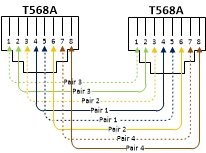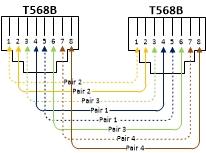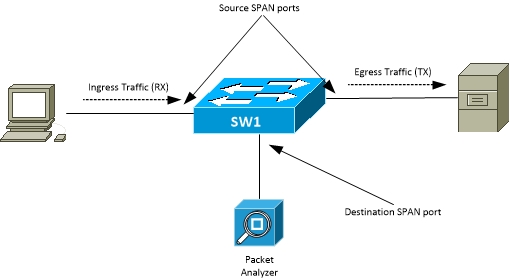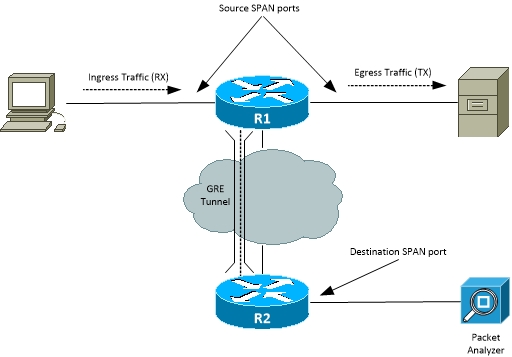Ethernet Standards and Cabling
Ethernet Standards and Cabling
Category 5 Connectors

[_/su_spoiler]
Category 5 Straight Through Cable
T568A to T568A

| End A Pin |
End B Pin |
Cable Colour |
Pair number |
| 1 |
1 |
Green/White |
3 |
| 2 |
2 |
Green |
3 |
| 3 |
3 |
Orange/White |
2 |
| 4 |
4 |
Blue |
1 |
| 5 |
5 |
Blue White |
1 |
| 6 |
6 |
Orange |
2 |
| 7 |
7 |
Brown/White |
4 |
| 8 |
8 |
Brown |
4 |
T568B to T568B

| End A Pin |
End B Pin |
Cable Colour |
Pair number |
| 1 |
1 |
Orange/White |
2 |
| 2 |
2 |
Orange |
2 |
| 3 |
3 |
Green/White |
3 |
| 4 |
4 |
Blue |
1 |
| 5 |
5 |
Blue White |
1 |
| 6 |
6 |
Green |
3 |
| 7 |
7 |
Brown/White |
4 |
| 8 |
8 |
Brown |
4 |
[_/su_spoiler]
Category 5 Crossover Cable
T568A to T568B

| End A Pin |
End B Pin |
Cable Colour |
Pair number |
| 1 |
3 |
Green/White |
3 |
| 2 |
6 |
Green |
3 |
| 3 |
1 |
Orange/White |
2 |
| 4 |
4 |
Blue |
1 |
| 5 |
5 |
Blue White |
1 |
| 6 |
2 |
Orange |
2 |
| 7 |
7 |
Brown/White |
4 |
| 8 |
8 |
Brown |
4 |
[_/su_spoiler]
Ethernet Standards
| Standard |
Description |
| DIX V2 |
Original Ethernet Standard specifications for Layer 1 and 2. From Digital / Intel / Xerox |
| 802.2 |
LLC (Logical Link Control). Layer 2 spec for headers common to multiple LAN specifications |
| 802.3 |
MAC (Media Access Control). Original Layer 1 and 2 spec, standardized using DIX as basis |
| 802.3u |
FastEthernet. 100Mb over copper or optical cables |
| 802.3z |
Gigabit Ethernet over Optical cables |
| 802.3ab |
Gigabit Ethernet over Copper cables |
| 802.3aq |
10Gb over MMF |
| 802.3an |
10Gb over UTP |
| 802.3ae |
10Gb over Fiber |
| 802.3ba |
40Gb and 100Gb over MMF/SMF |
[_/su_spoiler]
Cable Types and Distances
| Standard |
Cable Medium |
Cable Type |
Pairs |
Distance |
| 10Base2 |
Copper |
Thin Coaxial |
n/a |
185m |
| 10Base5 |
Copper |
Thick Coaxial |
n/a |
500m |
| 10BaseT |
Copper |
UTP Cat 3, 4, 5, 5e, 6 |
2 |
100m |
| 100Base-FX |
Fiber |
Multi-Mode |
n/a |
400m |
| 100Base-T |
Copper |
UTP Cat 3, 4, 5, 5e, 6 |
2 |
100m |
| 100BaseTX |
Copper |
UTP Cat 3, 4, 5, 5e, 6 or STP |
2 |
100m |
| 1000Base-LX |
Fiber |
Long-wavelength Single-Mode
Long-wavelength Multi-Mode |
n/a |
10km
3km |
| 1000Base-SX |
Fiber |
Short-wavelength Multi-Mode |
n/a |
220m (62.5micron)
550m (50micron) |
| 1000Base-ZX |
Fiber |
Extended-wavelength Single-Mode |
n/a |
100km |
| 1000Base-T |
Copper |
UTP Cat 5, 5e, 6 |
4 |
100m |
| 1000Base-CS |
Copper |
Shielded Twisted Pair |
2 |
25m |
[_/su_spoiler]
Other Category Cable Types
| UTP Category |
Speed |
Description |
| 1 |
n/a |
Telephone cable, not data |
| 2 |
4Mb |
Token Ring over UTP |
| 3 |
10Mb |
Telephone cable, old Ethernet |
| 4 |
16Mb |
Used in telephone networks to transmit voice and data |
| 5 |
1Gb |
Most common structured cable for data networks (100Hz) |
| 5e |
1Gb |
Higher transmission performance of Cat5 (100Hz) |
| 6 |
1Gb+ |
Replacement for Cat5e, supports higher speeds (250Hz) |
| 6a |
1Gb+ |
Replacement for Cat6, supports higher speeds (500Hz). Supports 100m distance |
[_/su_spoiler]
CSMA/CD
Carrier Sense Multiple Access / Collision Detection
- Used to deal with and minimise collisions on Ethernet multi-access network
- Defines how sending nodes can detect a collision and retransmit the frame
- Process:
- A node listens to see if the segment is not busy
- Node cant detect a carrier signal on the wire (Carrier-Sense)
- Node sends the frame
- If there is a collision, all nodes stop sending frames (back-off) and send a jam signal to notify all other nodes a collision has occurred.
- All sending nodes generate a randomized timer for “back-off” wait time.
- If any node was preparing to send, they receive the jam signal and wait for the back-off period of time before retrying
- Nodes try to retransmit the frame after a random time-out period
Speed and Duplex
Speed and Duplex
- Be default Cisco switches use auto-negotiation to determine speed and duplex
- Speed
- Can sense auto-negotiation speed using Fast Link Pulses (FLP)
- If auto-negotiation disabled other side, uses incoming electrical signal to determine speed
- Can be configured manually
- Command:
- (config-if)#speed < auto | 10 | 100 | 1000>
- Duplex
- Detects duplex settings through auto-negotiation only
- If negotiation disabled, falls back to default setting
- On Cisco switches default is
- Half-duplex (HDX) for 10/100 interfaces
- Full-duplex (FDX) for 1000 interfaces
- Can only use FDX when collisions can’t occur on wire
- Only possible when not using shared meduim e.g. Hub
- Can be configured manually
- Command:
- (config-if)#duplex <auto | half | full>
Layer 2 Addressing
Layer 2 Addressing
Ethernet Frame Headers
Ethernet (DIX) and Revised (1997) 802.3 header
| 8 Bytes |
6 Bytes |
6 Bytes |
2 Bytes |
Variable |
4 Bytes |
| Preamble |
Destination Address |
Source Address |
Type/Length |
Data |
FCS |
Original 802.3 Ethernet header
| 7 Bytes |
1 Byte |
6 Bytes |
6 Bytes |
2 Bytes |
1 Byte |
1 Byte |
1-2 Bytes |
Variable |
4 Bytes |
| Preamble |
SFD |
Dst Address |
Src Address |
Length |
DSAP |
SSAP |
Control |
Data |
FCS |
| <--------------------802.3--------------------> |
<----------802.2----------> |
|
<-802.3-> |
802.3 Ethernet and SNAP (Sub-Network Access Protocol) header
| 7 Bytes |
1 Bytes |
6 Bytes |
6 Bytes |
2 Bytes |
1Byte |
1 Byte |
1-2 Bytes |
3 Bytes |
2 Bytes |
Variable |
4 Bytes |
| Preamble |
SFD |
Dst Address |
Src Address |
Length |
DSAP |
SSAP |
Control |
OUI |
Type |
Data |
FCS |
| <--------------------802.3--------------------> |
<----------802.2----------> |
<----SNAP----> |
|
<802.3> |
-
Header Fields
- Preamble (DIX)
- Provides sync and signal transitions to allow proper clocking of transmitted signal
- Ends with binary 11
- Preamble and Start of Frame Delimiter
- Same as DIX preamble
- 802.3 just renames 8 Bytes DIX to 7 Bytes preamble and 1 Byte SFD
- Type (DIX)
- Identifies type of protocol that follows the header
- Allows receiver to know how to process the frame
- Type (SNAP)
- Uses same value as DIX Type field
- Used along side DSAP field
- Length
- Length in bytes of data following length field
- DSAP
- Destination Service Access Point
- Protocol type field
- 2 high-order bits reserved for other purposes
- 802.2 LLC
- SSAP
- Source Service Access Point
- Protocol type field that describes the upper-layer protocol that created the frame
- Uses same value as Ethernet Protocol Type
- Control
- Provides a mechanism for connection-orientated or connectionless operation
- Generally connectionless by modern protocol
- 0x03 value
- OUI
- Organizationally Unique Identifier
- Generally unused
- Provides a place-holder for the manufacturer of the NIC
[_/su_spoiler]
Ethernet Address Format
| MSB |
|
LSB |
| 1st Byte |
2nd Byte |
3rd Byte |
4th Byte |
5th Byte |
6th Byte |
| <----- OUI Vendor Code-----> |
<-----Vendor assigned-----> |
- MSB = Most Significant Byte
- LSB = Least Significant Byte
- 1st Byte (Most Significant Bit)
|
|
|
|
|
|
U/L
Bit |
I/G
Bit |
| 1st Bit |
2nd Bit |
3rd Bit |
4th Bit |
5th Bit |
6th Bit |
7th Bit |
8th Bit |
| MSB |
|
LSB |
- MSB = Most Significant Bit
- LSB = Least Significant Bit
- I/G = Individual/Group Bit
- 0 = address is unicast
- 1 = address is multicast or broadcast
- Multicast addresses always start with 0x01005E
- U/G = Universal/Local Bit
- 0 = Vendor assigned
- 1 = Administratively assigned
[_/su_spoiler]
SPAN, RSPAN and ERSPAN
SPAN, RSPAN and ERSPAN
- Allows the capture of traffic to send to a network analyzer or sniffer
- 2 different sections:
- Source of capture
- Destination to send captured traffic
- Source of traffic
- Captures traffic on Interface or VLAN
- If VLAN all ports on that VLAN are monitored
- Can capture traffic flow
- Ingress (RX) traffic
- Egress (TX) traffic
- Both directions (Default option)
- Can be any type of port:
- Access
- Trunk
- Can filter specific VLANs being monitored by using filter vlan option
- Routed
- Etherchannel
- Single physical interface
- Entire EtherChannel logical port
- Destination to send captured traffic:
- Can be local SPAN or remote SPAN
- Original port config is overwritten when enabled as a SPAN destination port
- When the SPAN configuration is removed, the original configuration is restored
- All traffic manipulation happens before sending to SPAN destination
- Normally ignores control-plan traffic and doesn’t send to SPAN destination
- e.g. STP, CDP, DTP, etc.
- Can be configured manually by using command:
- (config)#monitor session <session id> destination interface <IF> encapsulation replicate
- Destination can not be part of an EtherChannel
- Doesn’t support security features
- e.g. port security, 802.1x, PVLANs, etc.
- Destination doesn’t run control-plane protocols
- Up to 64 destination ports can be configured
- Layer 2 or Layer 3 destainations
- SPAN destination can capture ingress traffic from destination port
- Can capture untagged traffic and set to specific VLAN
- Command:
- (config)#monitor session <session id> destination interface <IF> ingress vlan <vlan-id>
SPAN
- Switch Port Analyzer
- Operates on a single device only
- Destination has to be a local port on the switch

- Source Commands:
- (config)#monitor session <session id> source [interface | vlan] <IF/VLAN> [tx | rx | both]
- (config)#monitor session <session id> filter vlan <vlan id(s)>
- Enables VLAN filtering if source is VLAN
- Destination Commands:
- (config)#monitor session <session id> destination interface <IF>
- (config)#monitor session <session id> destination interface <IF> encapsulation replicate
[_/su_spoiler]
RSPAN
- Remote Switch Port Analyzer
- Same principle and configuration as SPAN
- Destination port is on remote switch
- Need to configure a dedicated RSPAN VLAN and send on trunk between switches
- Session IDs on each switch do not need to match

- RSPAN Source Switch Commands:
- (config)#vlan <vlan-id>
- (config-vlan)#remote span
- (config)#monitor session <session id> source [interface | vlan] <IF/VLAN> [tx | rx | both]
- (config)#monitor session <session id> destination remote vlan <RSPAN VLAN>
- RSPAN Destination Switch Commands:
- (config)#vlan <vlan-id>
- (config-vlan)#remote span
- (config)#monitor session <session-id> source remote vlan <vlan-id>
- (config)#monitor session <session id> destination interface <IF>
[_/su_spoiler]
ERSPAN
- Encapsulated Remote Switch Port Analyzer
- Cisco proprietary
- Same principle as RSPAN
- SPAN traffic encapsulated within GRE and forwarded to remote destination instead of using VLAN
- Supports traffic capture on interfaces or VLANs
- IP address and origin IP address used as destination and source of the GRE wrapper
- ERSAN ID matches the SPAN flows
- Can use QoS to mark SPAN traffic
- Can separate traffic out into VRF
- Only supported on:
- Catalyst 6500
- 7200
- Nexus 7k
- ASR 1000

- ERSPAN Souce Device Commands:
- (config)#monitor session <session id> type erspan-source
- (config-mon-erspan-src)#source interface <IF> [tx | rx | both]
- (config-mon-erspan-src)#no shutdown
- (config-mon-erspan-src)#destination
- (config-mon-erspan-src-dst)#erspan-id <erspan-id>
- (config-mon-erspan-src-dst)#ip address <ip address>
- (config-mon-erspan-src-dst)#origin ip address <ip address>
- ERSPAN Destination Device Commands:
- (config)#monitor session <session-id> type erspan-destination
- (config-mon-erspan-dst)#destination interface <IF>
- (config-mon-erspan-dst)#no shutdown
- (config-mon-erspan-dst)#source
- (config-mon-erspan-dst-src)#erspan-id <erspan-id>
- (config-mon-erspan-dst-src)#ip address <ip address>
[_/su_spoiler]
SPAN Troubleshooting Commands
SPAN Troubleshooting Commands
- #show monitor session all - Displays information on all created SPAN sessions
- #show monitor session <session id> [detail] - Displays [detailed] information on specific SPAN session
- #show monitor session erspan-destination [detail] - Displays [detailed] information on ERSPAN destination
- #show monitor session erspan-source [detail] - Displays [detailed] information on ERSPAN source
- #show monitor session local - Only shows local SPAN sessions
- #show monitor session remote - Only shows remote SPAN sessions
- #show monitor session range <range> - Displays information on a range of SPAN sessions
- #show vlan remote-span - Displays information about Remote SPAN VLANs
[_/su_spoiler]
Smartport Macros
Smartport Macros
- Allows you to create a macro and apply to a range of interfaces
- Defines a set of common configuration commands on interfaces
- Procedure:
- Define an interface range including macro name, where to apply to macro
- Command:
- (config)#define interface-range <macro-name> <interface range>
- Define the macro interface configuration
- Commands:
- (config)#interface range macro <macro-name>
- (config-if)# <commands to apply to macro>
- Display Smartport macros that currently exist ion switch
- Command:
- #show parser macro [brief]
- #show parser macro name <macro-name>











